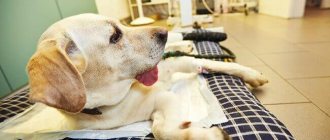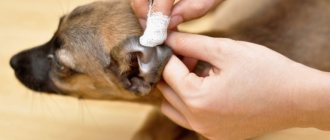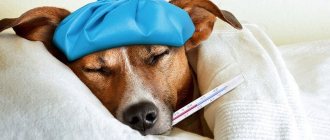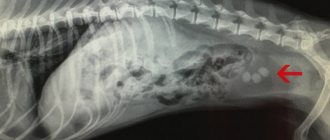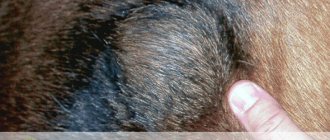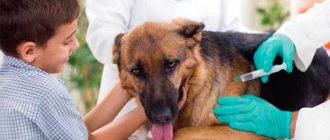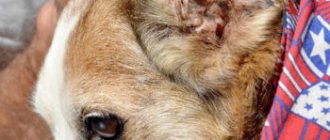When should you be wary?
The first thing to understand is that spinning before bed is normal. Before domestication, wild dogs crushed grass under them or dug holes to shelter from the weather.
They speak about illness only when the animal begins to cut circles too long and too often. If there are no obvious incentives for such actions, sound the alarm. In such cases, the cause often lies in mental disorders or brain injuries. In addition to whirling, the condition is accompanied by:
- catching and biting the tail;
- barking for no reason;
- prolonged pursuit of shadows or sunbeams;
- licking or chewing the skin on the paws and tail;
- long walking or running along the same route;
- over-indulgence in one or more toys.
Due to the regular repetition of obsessive actions, your beloved pet forgets about food and water, depleting his body. Scratching appears on his body, fraught with secondary infection. If these symptoms appear, contact your veterinarian immediately. After examining the patient, he will be able to confirm suspicions or refute them by discovering physiological causes.
Physical and intellectual stress
Every dog needs a certain level of exercise, physical and intellectual. Activity needs vary from breed to breed. However, there are general recommendations that are suitable for almost every animal.
- The dog needs at least half an hour of aerobic exercise (running, swimming). Sufficient physical activity allows the animal to relax and calm down, distracting it from factors that cause anxiety and stress. It is especially important not to neglect training with your dog on days when he may be faced with a frightening situation.
- Active games in the fresh air allow the animal to get rid of excess energy and get into a good mood.
- Frequently changing the route of daily walks gives the dog the opportunity to get acquainted with new smells, objects and sounds and diversifies its life.
- Social contacts with other dogs (games) without a leash, the opportunity to enjoy long runs and the company of active animals improves the dog’s quality of life, reduces anxiety, and allows it to adapt to interactions with unfamiliar animals and people.
To successfully treat your dog and ensure a decent quality of life, it is advisable to contact a professional trainer. It is highly recommended that an inexperienced owner take a training course under the supervision of a specialist.
Reasons for unusual behavior
To determine the possible cause, you will need to analyze the age of the animal and the presence of accompanying symptoms. If unusual behavior is uncharacteristic for your pet and appeared quite recently, try to remember events that could provoke the changes that occurred.
Play - at a young age
Puppies are very energetic, so owners rarely manage to extinguish their energy. With a busy work schedule, daily walking is not enough. In such cases, running or walking in circles is natural.
An abundance of energy is typical for dogs under 5 years of age. If your pet has no alarming symptoms, and unusual behavior is always accompanied by a playful state, don’t worry. There is a pattern to such hyperactivity. Circles begin soon after returning from a walk, meeting the owner from work, bathing or feeding.
Owners of older dogs will have to look for other reasons. The only exceptions are small-breed dogs, which do not lose their temper even at an advanced age.
Physiological discomfort
Cutting circles is typical for animals living in confined spaces. Small enclosures, tiny booths and life on a leash are not the best conditions for keeping. If your pet performs a security function, do not forget about regular walks in a spacious area.
Other causes of physiological discomfort may include pain and itching. The dog may roll on its butt, chase its tail, and constantly bite its limbs. Irritating factors are only secondary reasons. To eliminate them, you will have to establish the main problem: gastrointestinal diseases, allergies, hormonal imbalances or other pathologies.
Neurological problems
One in fifty dogs is diagnosed with obsessive-compulsive disorder (OCD). This mental disorder consists of the regular repetition of obsessive actions (compulsions) aimed at suppressing frightening or disturbing thoughts (obsessions). It is caused by constant stress and anxiety, including:
- physical violence from owners or aggression from other pets;
- isolation from other animals and people;
- keeping on a leash or in a small room;
- lack of attention and prolonged loneliness;
- inconsistency in prohibitions and punishments.
Obsessive paw licking may be due to negative experiences in the past. Street animals that have been frequently abused become accustomed to licking their wounds. Finding themselves in good conditions, they continue to perform their usual actions without thinking about their appropriateness. This greatly hinders the determination of the stress factor.
Regular repetition of damaging actions is fraught with the development of dermatological diseases. OCD requires medication and psychological help. Those at risk include golden retrievers, bull terriers, Dobermans, German shepherds and Labradors.
Diseases and injuries
Symptoms characteristic of OCD may accompany other pathologies. Behavioral changes caused by irritating factors are characteristic of the following diseases:
- Allergy. Allergic reactions are often accompanied by itching. To eliminate unpleasant sensations, dogs scratch, lick or bite into the affected parts of the body. Symptoms are complemented by redness, peeling and partial baldness.
- Infections. Long-term infection with viruses or bacteria can cause severe pain. The pet constantly whines, refuses to eat, hides in secluded corners and suffers from intestinal upset.
- Traumatic brain injury. Any damage to the brain affects the nervous system, leading to loss of coordination.
- Parasitic infestations. Cutting circles followed by tail biting appears when infested with fleas. If the animal is infected with helminths, then due to severe itching it can move on the floor.
- Deterioration of vision. Loss of visual function leads to disorientation. The pet gets lost in its usual space: it often freezes in place or walks in circles for a long time.
- Hepatoencephalopathy. This metabolic disease, accompanied by a disorder of the nervous system, occurs due to congenital or acquired liver pathologies. The exact mechanism is unknown, as the problem is sometimes caused by infection. The patient experiences epileptic seizures, vomiting, bloody diarrhea, drowsiness, agitation or lethargy.
Each problem requires individual treatment. To make a diagnosis, you need to contact a veterinary clinic.
How to get rid of an unwanted habit
First of all, it is necessary to find out what are the reasons why the dog rushes to chase itself.
Behavioral characteristics can be easily recognized. If the dog or puppy does this for fun, the movement is not intrusive. They easily forget about it as soon as the owner offers them a more exciting activity. The owner needs to carefully examine the back of the thighs, croup and anus area for causes of possible discomfort (coat problems, improperly docked tail, etc.).
If the discomfort is caused by any internal pathology, then only certain treatment will help:
- in case of allergic reactions, use antihistamines;
- inflammation of the paraanal glands is eliminated by cleaning them using anti-inflammatory and antiseptic agents;
- Prevention of helminthiasis consists of regular deworming with special complex means.
Treatment for catch-the-tail syndrome is the most difficult. It is almost impossible to completely defeat it, since it is of genetic origin. All therapeutic measures used are symptomatic, and if they are canceled, relapses of the disease will recur. Moreover, it is useless to apply punishment to the dog, to put on a muzzle. The obsessive desire to perform this or that action will not disappear.
The main goal of the owner is to reduce the increased level of anxiety and eliminate the formed bad habit. In a calm environment, behavioral adjustments are made aimed at distracting the animal from obsessive actions through positive reinforcement and developing a new reaction to the irritating factor. Competitive behavior training is used when, when circling resumes, the dog is given commands that it has already been trained in advance. Having achieved their fulfillment, the dog is rewarded with affection or a treat, gradually weaning him from unwanted actions and reinforcing a positive association.
Thus, we figured out why the dog chases its tail. This action may be a variant of the norm, or it may indicate pathology. But in all cases, the dog’s life should be filled with positive communication with the owner and interesting activities, which will also serve as a distraction factor. This could be walks, joint activities that help realize the hunting instinct in the form of running after a mechanical hare or fetching.
There is no doubt that a dog having a seizure is a terrible event that is very upsetting for the owner. But if you can recognize the symptoms of the onset of an attack, you will have time to take him to the vet. Of course, seizures in dogs are not always smooth sailing and can have serious health consequences. It is important to understand what a seizure is and what its causes are in order to avoid severe consequences.
What can be done
Further actions will depend on the reason. Sometimes the previous condition returns with proper care and maintenance. In more severe situations, psychological adjustment, psychotropic or other drugs are used.
Upbringing
If the reason is excess energy, then try to diversify your daily activity. Suitable for this task:
- outdoor games with a stick or Frisbee;
- free walking in the company of other animals;
- regular physical activity, including jogging or swimming;
- periodic changes in usual routes.
To switch attention, teach your pet basic commands. This can be done independently or together with a dog handler. A controlled urban dog (UCD) course is suitable as a basis. Following commands will help distract the animal from unwanted actions.
Psychological adjustment
If neurological problems are detected, all possible stress factors must be eliminated. If an animal is afraid of New Year's fireworks or thunderstorms, then you will have to resort to reducing emotional outbursts (desensitization) by creating a positive association.
Behavioral therapy is carried out only under the supervision of an animal psychologist. The animal is regularly introduced to the stimulus, combining the resulting anxiety with affection or interesting games. Over time, unpleasant situations begin to be associated with positive experiences. This helps manage stress and eliminate compulsive behavior.
When are medications needed?
Drug treatment is used for illnesses or long-term OCD. In the second case, medications are prescribed in conjunction with behavioral therapy. This helps reduce the frequency and intensity of clinical symptoms by more than 2 times. Recommended medications include fluoxetine or clomipramine. These substances are used to treat psychosis not only in animals, but also in humans.
In all other cases, the veterinarian may prescribe antibiotics, anthelmintics, hepatoprotectors, antihistamines or acaricidal drugs. For serious disorders, treatment is carried out in a hospital.
What is not recommended to do
Avoid judging or encouraging unwanted compulsions. Aggression from the owner will further aggravate the disorder and complicate further treatment.
Remember that you cannot correct behavior on your own. Having noticed the weasel, the animal will be convinced of the correctness of its actions. It is only permissible to switch attention to games or follow commands.
Take care of your pet and minimize possible stressors. OCD is difficult to permanently eliminate, so its treatment is aimed at reducing and controlling new compulsions. If alarming symptoms appear, do not delay diagnosis. The sooner the veterinarian examines the animal, the greater the chance of preventing the development of complications.
The article is for informational purposes only. Contact your veterinarian!
What to do if your dog is walking in circles?
- If you conclude that the dog is walking or running in circles due to age and unspent energy, and you do not observe signs of illness, then you can do nothing. Or, as an option, simply direct the dog’s energy in the right direction: train, give commands, and reward them with treats for correct execution.
- In situations where a dog suffers due to conditions of detention, stress, fear, lack of freedom or attention, the conclusion suggests itself. It is necessary, if possible, to correct the deficiencies that led to the dog’s restless behavior. If there are any other alarming symptoms, it may be worth talking to your veterinarian. For psychosis, the doctor will help you individually select psychotropics, vitamins, and immunocorrectors.
- The most difficult situations often require inpatient treatment and rehabilitation. In case of illness, the veterinarian will tell you which diagnostic method is optimal for your pet. An examination by a neurologist will almost certainly be required. In case of hepatoencephalopathy, intravenous infusions of Reamberin are most likely needed. Also, if necessary, Plasma, Refortan, Ringer, Glucose with hepatoprotectors, gastroprotectors, antibiotics, immunostimulants, and so on are prescribed.
As often happens, owners uninitiated in medical subtleties see only a symptom, the tip of the iceberg. In order to prevent the development of a serious disease, loving dog owners prefer to call a veterinarian at home or go with the animal to the clinic.
Any form of dog behavior has its own motivation. Many people are familiar with the situation when a dog chases its tail, and, having grabbed it, begins to torment and gnaw at it. What explains this rush? There can be quite a few reasons and not all of them are harmless. In some cases, such behavior indicates that the dog is seriously ill, which means he needs veterinary care. The pathology is called “caught-tail syndrome.” From this article you will learn why your dog behaves this way and how to wean it from this bad habit.
Types of stroke and causes
Ischemic stroke occurs due to blockage of blood vessels in the brain. It can be triggered by:
- poisoning with toxic substances;
- worms that have migrated to the brain;
- head injuries;
- cardiovascular diseases;
- liver diseases;
- diabetes;
- diseases of the urinary system.
Hemorrhagic stroke occurs due to rupture of blood vessels in the brain as a result of thinning of the walls or increased pressure. The cause may be stress or overexertion.
Adult dogs over seven years of age, representatives of large breeds, pets living in large cities, and animals with an unbalanced psyche are more prone to stroke.
Dog training
Every dog owner is recommended to take a general training course (GTC) with their pet. This will not only allow you to discipline the dog and teach it a simple set of actions, but will also help the owner better understand his pet, deepen the relationship between the owner and the dog, and make it possible to identify the characteristics of the dog’s temperament. Classes with a professional trainer will “tune” you to interact with your pet, open up new opportunities for interaction, and allow you to better understand the dog’s needs. The skills obtained as a result of training can then be used in treating the dog.
To switch the dog's attention, it is often enough to give the animal a command that has already been learned. So, if the dog starts compulsively running or walking, you can command “sit” or “lie down”. This will stop the wrong behavior. Then it makes sense to offer the dog an interesting activity or game that is different from being obsessive.
Symptoms of a stroke
Suspicion of a stroke should be caused by the following symptoms:
- different pupil diameters;
- paralysis of one or more limbs;
- disorientation;
- seizures similar to epilepsy.
During and after an attack, the pet behaves unusually: it backs away, falls to the side, walks in circles, and cannot drink or eat on its own.
Any of these symptoms must be responded to quickly, because without the help of a veterinarian, the dog can fall into a coma within a few hours.
Diagnosis and treatment
During the examination, the doctor may prescribe:
- blood and urine tests;
- X-ray and ultrasound of the lungs;
- EEG and MRI of the brain.
The severity of the disease depends on the size of the affected area of the brain.
Timely treatment has a favorable prognosis. The course lasts about two months and includes:
- first emergency aid;
- drug therapy, which includes tranquilizers, antioxidants, antispasmodics, vitamins;
- rehabilitation therapy;
- a diet based on low-fat foods.
The consequences of a stroke can be disruption of the dog’s musculoskeletal system, partial or complete paralysis of the limbs. That is why you should not neglect restorative therapy and refuse and stop treatment as soon as your pet gets better.
The necessary care, treatment and attention from the owner can return the pet to a full life.
Animals do not behave like humans when they are in pain. It is worth remembering that they have a fairly high pain threshold, that they will hide their suffering until the last moment (it is nature’s nature not to show weakness) and that they will not point a clawed finger at a ripening abscess.
Often, owners do not understand why, during illness, their pet behaves differently than usual, for example, it becomes withdrawn and unsociable, may bite, or goes away and hides. Just as often, owners attribute changes in behavior to something, such as the weather or a “bad mood,” when the animal is simply in pain.
There are, of course, manifestations of pain that cannot be confused with anything, for example, lameness. But otherwise, it’s unlikely that your dog will come up and say: “Master! My back hurts around the kidneys! I need to see a doctor!”, no, she will sit tense with a hunched back and suffer in silence.
Pain is one of the most obvious symptoms, so owners usually notice it first. Pain is a reason to contact your veterinarian immediately. External manifestations often depend on the intensity and location of the pain, but after living a little with a dog and getting to know the pet better, everyone sooner or later begins to understand its body language.
Symptoms of pain. Let's look together at which of them are most common:
1) The dog barks, whines, howls, growls. May do this in conjunction with some action (for example, growling at a sore paw) or simply lie/sit/stand, stare into space and whine. This also includes whining and squealing when trying to be picked up. Many dogs even in their normal state vocally accompany their behavior, for example, barking when they are happy or whining when begging. This is fine. BUT if your pet makes sounds more than usual or accompanies them with atypical behavior, this is a reason to be wary. I have a patient who barks when he has colic and stomach pain. He's already a loud enough dog, but if it hurts... he doesn't shut up.
2) Excessive grooming. Dogs try to clean their wounds, so cuts, abscesses, broken claws, and abscesses are actively licked. If a dog frequently or continuously licks a certain place, then you need to look for a problem there. This also includes several other situations: - if the eyes hurt or itch, the dog rubs them with his paw or rubs them against various objects in the house. — some dogs bite the place where it hurts. The more it hurts, the more intense it is. - if teeth hurt or problems in the mouth or throat - the dog puts its paws into its mouth, tries to gnaw hard objects, scratch, rubs its muzzle on hard surfaces. - if there are problems in the genitals (especially in males), this area is also subject to active grooming.
3) Sleep disturbance. The dog begins to sleep a lot or, on the contrary, cannot sleep for a long time and constantly wakes up. It will be the first or the second, depending on the nature of the pain.
4) Violation of food and water intake. If a dog has pain in the mouth, throat, or stomach, it may refuse to eat food, and sometimes even water. Also, refusing to eat can mean nausea and excessive pain in other areas. In some inflammatory processes, the amount of water consumed increases.
5) Shortness of breath, heavy and/or shallow breathing. The most obvious sign of severe pain. Sometimes, the only one.
6) Forced posture and anxiety. If the dog constantly changes position, lies down and immediately gets up, walks, looks for a place, lies down and gets up again, then something is bothering him. It happens that when there is pain in certain areas, dogs take a forced position: for example, a hunched back is a sign of pain in the abdominal cavity. Walking in circles and chaotic movements can also be a sign of anxiety. The dog may have difficulty or be reluctant to lie down or get up, or refuse to jump on the sofa.
7) Unmotivated aggression. Often, a dog may show dissatisfaction if you touch a sore spot, sometimes going so far as to growl and bite if the owner puts too much pressure on a sore paw or stomach. Before looking for a psychological aspect in a dog’s aggression, we need to understand whether the dog is telling us that we don’t need to touch it in this place. Aggression can also be a sign of constant irritation against a background of pain; pain sometimes causes inappropriate behavior in both people and animals.
 Sociability. Every dog reacts differently to feeling unwell. One will hide away so as not to be touched, and the other, on the contrary, will constantly stay close and put the place that hurts under the arm so that it can be stroked (this does not apply to all types and places of pain). An attentive owner who has known his pet for a long time will immediately notice that the dog’s behavior has changed.
Sociability. Every dog reacts differently to feeling unwell. One will hide away so as not to be touched, and the other, on the contrary, will constantly stay close and put the place that hurts under the arm so that it can be stroked (this does not apply to all types and places of pain). An attentive owner who has known his pet for a long time will immediately notice that the dog’s behavior has changed.
9) Lameness, abduction or curling of the paw. Lameness is the most visible symptom of pain. Just remember that if an animal limps or stretches its paw, this does not always mean problems with the limbs; sometimes lameness is a sign of pain in some abdominal organs or pain in the spine. This also includes the so-called “wooden gait”, any changes in gait.
10) Unusual behavior when urinating and defecating. An attempt to move during urination and defecation, to find a different position, an atypical position, frequent urges, vocal accompaniment - all this indicates that there is a problem.
11) Other possible symptoms of pain in dogs: - Frequent or intense staring at the offending body part. Sometimes surprised, sometimes aggressive. - Tilt the head to one side. It may be a sign of neurological problems, as well as pain in the ears, any part of the head, otitis media. - Cramps. Especially in brachycephalic breeds. For example, seizures in a French bulldog is a reason to find an orthopedist and examine the dog for a sphenoid vertebra.
PS While I was writing this article, I remembered how my dog “didn’t like” beef lungs. This is someone who can reveal all their pain in a theatrical mini-production! At first he looked back at his stomach, often, and when it was seething, also with great surprise. Then he climbed onto the sofa (which he absolutely cannot do), placed his entire heavy body in my arms, hunched over and froze. Here it is, the picture: “Colic, pain and spasms in the intestinal area”!
Be attentive to your dogs, do not miss the symptoms of pain in their behavior! Every caring owner should try to provide the necessary veterinary care to their beloved pet in a timely manner!
The article used materials from this site.
Reasons why a dog may spin around itself
This behavior is not always a deviation or a sign of a disease. For example, if a dog is spinning behind its tail, it is young and playful, then, most likely, this is just entertainment, so it gives an outlet for its energy. For many dogs, “circling in circles” is a residual phenomenon of survival instincts in the wild, while for others it is a sign of gastrointestinal diseases, stress or mechanical injuries.
To understand whether you should worry, pay attention to:
- pet's age;
- the presence of other symptoms of disease;
- changes in usual lifestyle.
Expert opinion Olga Olegovna Kuzmenko If the habit of spinning around its axis has already appeared in an adult dog, analyze what has changed in his life. Perhaps food, place of residence, family composition.
Before bedtime
Many dogs spin around themselves before lying down, and this habit has been going on for a long time. Dogs were not always domestic dogs; they had to survive in the wild. 360 degree rotations made it possible to check the safety of the area and whether there was an enemy nearby.
The second aspect, dating back to the same times, is the need to prepare the bed. There were no comfortable beds before, and animals had to make their own bed. With their paws they smoothed the grass or crushed the snow, scared away insects, and made a rounded “bed”. Instinctively, it seems that in the “nest” it is more difficult for the predator to notice the prey.
Games
One of the favorite games of young dogs is catching their tail. She is safe and very fun to watch. Puppies can have fun in this way until they are 4-5 years old. Sometimes this indicates insufficient physical activity. There are no pathologies if:
- While running, the pet is in a playful mood.
- There are no symptoms of disease.
- Whirling occurs after some event: swimming, a walk, the owner returning home.
If you see that your pet really wants to play, give him some time. It’s better for him to throw out energy in a peaceful direction than for you to find a torn pillow or slippers later.
Discomfort
If a dog is spinning around and whining, then it is experiencing discomfort. There may be several reasons for its appearance. The first is pain or itching, feeling unwell. Check:
- Do you have a fever (dry, warm nose);
- mouth (mucous membranes should not be bright red);
- stool (is there any disorder or constipation);
- how does the dog eat, has his appetite changed;
- is there any redness on the skin?
A common cause of physiological discomfort is lack of space (leash, cramped enclosure). Remember that no matter what purpose you keep your pet, it definitely needs to exercise a lot and have comfortable living conditions.
If a dog bites its tail and spins around, then the discomfort is caused by problems with the gastrointestinal tract; it may be painful or difficult for it to go to the toilet.
Neurological problems
Dogs are emotional creatures and what may seem normal to a person becomes very stressful for an animal. To suppress fears and obsessive thoughts, the dog begins to perform repetitive actions, this is called obsessive-compulsive disorder. It is diagnosed in 2 out of 100 dogs.
Its causes are:
- Loneliness, isolation from people and other pets.
- Aggression, physical impact from owners.
- Inconsistency in the manner of parenting (you cannot first allow something and then unexpectedly punish for similar behavior).
- Enclosed space (regardless of whether the dog is in an apartment or in a booth, he needs to be given freedom periodically).
Doberman Pinschers, Labradors, Bull Terriers, and German Shepherds are prone to this disorder.
Diseases, injuries
Repetitive actions are different. Dogs that have lived on the street often develop the habit of circling and licking their paws. This complicates diagnosing the problem, since the limbs in this case turn out to be completely healthy. Their “treatment” is an acquired instinct of the dog.
But you still need to pay attention to such symptoms, since they often signal pathologies such as:
- Mechanical injuries, bruises of the paws, back of the body. It may be painful for the animal to sit or lie down.
- Infection with helminths causes itching in the anus, so the dog spins around on its butt, bites its tail, and behaves restlessly. Signs of the presence of parasites are increased appetite without weight gain, rapid weight loss, and the presence of blood streaks in the stool.
- Infectious diseases (viral, bacterial) provoke pain. The dog will whine, hide, and refuse to eat. His anxiety may manifest itself as running in circles.
- Allergic reactions cause severe itching at the site of irritation. The animal will try to get rid of it by licking and gnawing out the disease. Additional symptoms of dermatitis are peeling, redness of the skin, and partial hair loss.
- Loss of coordination is caused by traumatic brain injuries. The pet simply cannot sit or lie down the first time.
- A similar problem is caused by visual impairment. The animal may freeze in place, spin, or bump into walls or other obstacles.
- Often an old dog spins around in one place due to problems with joints and poor coordination of movements.
- Hepatoencephalopathy. The disease is accompanied by neuralgic disorders and occurs due to liver dysfunction. The condition is serious, characterized by vomiting, diarrhea (including blood), epileptic seizures, severe agitation or apathy.
If the dog is spinning around itself, determine the disease. Pay attention to how your pet is feeling, its behavior and other symptoms. Consult your veterinarian as each condition requires an individual treatment regimen.
The second case is neurological problems: fears, phobias, psychoses, stress.
For example, a dog is in a small confined space that it cannot leave itself, or freedom of movement is limited by a chain. Or the living conditions of the animal leave much to be desired. Stress can be triggered by various reasons, including the behavior of the owners - when they behave harshly, aggressively, and pay little attention to their pets.
What to pay attention to:
the above does not necessarily lead to stress and problems. What causes anxiety in some dogs is completely normal for others. However, if you suspect a neurological problem and its cause, you may want to talk to a veterinary neurologist about it.
When should you worry about your pet's health?
Having considered all the reasons, we understand that a pet circling around itself can be either a completely harmless phenomenon or a sign of a serious illness. You should be wary if:
- This behavior has not previously been observed in an adult dog;
- the dog is restless, worried, whining;
- There are other symptoms of pathologies.
Expert opinion Olga Olegovna Kuzmenko Do not determine the cause yourself, consult a doctor. Don't believe the misconception that if a dog bites its tail and spins, it must have worms. Be aware of other possible reasons for the behavior.
What is better not to do?
However, there are some things you should definitely avoid when your dog is this hyperactive: Don't chase him. This can send a bad behavioral signal, especially if this is a puppy that is just learning how to function properly in the world. Instead, if you need to stop the zoomie, say the dog's name out loud. Hopefully this will awaken her to obedience.
How to fix the problem?
The method for solving a problem directly depends on its nature:
- You can do nothing about playfulness at a young age; it’s good if you can provide your pet with more active games and long walks. Teaching commands helps, they shift attention from unwanted actions.
- If the dog is experiencing stress or physiological discomfort, it must be addressed. For short scares, such as fireworks, form positive associations. Long-term behavioral therapy should be carried out under the supervision of an animal psychologist. It is based on establishing a connection between the stimulus and affection, play, and encouragement.
- For severe obsessive-compulsive disorder, medications are prescribed.
When diseases or injuries are detected, the veterinarian prescribes treatment. Antihistamines for allergies, anthelmintics for parasite infections, hepatoprotectors, antiviral and antibacterial agents in cases of serious pathologies and infections.
Changing the situation
First, it is recommended to identify the situations that provoke your dog’s obsessive actions. Having identified them, they must be avoided, this will significantly reduce the level of anxiety and stress in the animal. However, it is impossible to avoid situations that frustrate the dog, such as a thunderstorm, a smell that frightens the animal, or a certain type of noise. Special training as part of behavior therapy will help the animal learn to react differently to a situation that cannot be prevented. Thanks to training, the level of anxiety will significantly decrease, which will lead to stabilization of your pet’s psychological state.
What can't you do?
If your dog has OCD, you shouldn’t scold him; punishing him will only make the situation worse. Encouraging the animal to calm down is also not recommended; the pet will take this as permission to continue this behavior. The best option is to contact a specialist; the situation can be corrected by switching attention and practicing commands.
In case of illnesses or injuries, it is also impossible to scold an animal for spinning or whining. The dog will experience both physiological pain and stress, this will complicate the course of the disease.
Remember that you are responsible not only for the dog’s behavior, but also for its health and mood. They will be good, with constant care and comfortable living conditions. Be attentive to alarming symptoms and don’t worry about trifles.
Good afternoon. Something incomprehensible is going on with a chihuahua dog, 5 years old, boy. We’ve been to the best clinics in the city, no one really says anything other than problems with the head. Help me please! A year ago, the dog began to walk with his head slightly lowered and turned to his side, after a few days his head became more twisted, and the dog began to walk along the wall - we went to the clinic, they did an x-ray for us - they said that he had an injury (subsequent veterinarians, looking at his behavior and the x-ray, refuted this theory). In winter, the dog goes to the toilet at home, go out with it for a walk with warm wraps on your chest. At home the dog started walking in circles. The next day (two) the dog could not stand - he fell over on one side (as if one side was stronger and the other weaker, so he fell over), he could not walk for about a week or two - they took him to the veterinarian, gave him general strengthening anti-inflammatory injections, vitamins that nourish the brain, magnetic procedures, massage, trained the paws by bending and unbending for 20 minutes) - they said it looked like a stroke but did not make a diagnosis, they talked about an MRI, but they said that the dog might not come out of anesthesia. They gave injections for 5 days and after a week for 7 days. Over time, the dog stood up and began to walk, and by June it was almost back to normal. In August, the dog was left with a relative for 3 days; upon arrival, he had another attack, but in a milder form. Walks in circles, disorientated, cannot eat - lowers his head (can’t see the cup), hand feeds, snatches and chews food well, drinks on his own, but to do this we raise the cup higher and forcefully tilt his head. Takes a strange position, sits on his hind legs, the front legs stretch forward and his head is thrown back (almost reaching his back). There is tone in the legs, the neck is not tense. They gave me IVs 5 times and 9 times (at this clinic they said it was a stroke) they injected me with vitamins, tonics and to improve brain nutrition) They did blood and liver tests - everything was fine. He began to return to normal, in early December, he began to walk in circles again (walks in one direction, lies on the same side), becomes dizzy and sits in a “head back” pose.. I read on the Internet that it looks like vestibular syndrome (disorientation, distorted muzzle ( as if he began to cross-eyed, sometimes when walking his hind legs get tangled, he moves his head as if he was watching something), according to the recollections that his ear was peeling and was red, they decided to give antibiotics, gave him something to drink for 5 days, there were no specific changes. They checked all the reflexes paws, all reflexes are normal. The dog stopped barking, but when exactly they didn’t pay attention, because he rarely barked in principle. Help with making a diagnosis? or an exception .. I read that during a stroke, everything appears at once, it’s like it’s increasing within a few days. How can I stop walking in circles? Is there really a risk with an MRI that he won’t wake up?
The number of periods of hyperactivity decreases with age
This behavior is most common among puppies. Don't be alarmed if your pet experiences a hyperactive episode more than twice a day. Owners should not be alarmed if the number of such periods decreases with age.
This is a normal part of a dog's maturation process. Most say that the puppy is actually testing his limits and how much activity he can handle at that point in time. Additionally, an older dog will sometimes become hyperactive if it observes a puppy doing the same thing, presumably in an attempt to relive its youth.
10 Beautiful Celestial Events to Watch in 2021
18th-century leather bags with cartridges inside were found by divers on a sunken ship
During Filaret's funeral service, people looked into the sky and saw doves: video

